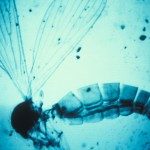Lien vers Pubmed [PMID] – 23151511
Proc. Natl. Acad. Sci. U.S.A. 2012 Dec;109(51):E3604-13
RNA viruses in insects are targets of an RNA interference (RNAi)-based antiviral immune response, in which viral replication intermediates or viral dsRNA genomes are processed by Dicer-2 (Dcr-2) into viral small interfering RNAs (vsiRNAs). Whether dsDNA virus infections are controlled by the RNAi pathway remains to be determined. Here, we analyzed the role of RNAi in DNA virus infection using Drosophila melanogaster infected with Invertebrate iridescent virus 6 (IIV-6) as a model. We show that Dcr-2 and Argonaute-2 mutant flies are more sensitive to virus infection, suggesting that vsiRNAs contribute to the control of DNA virus infection. Indeed, small RNA sequencing of IIV-6-infected WT and RNAi mutant flies identified abundant vsiRNAs that were produced in a Dcr-2-dependent manner. We observed a highly uneven distribution with strong clustering of vsiRNAs to small defined regions (hotspots) and modest coverage at other regions (coldspots). vsiRNAs mapped in similar proportions to both strands of the viral genome, suggesting that long dsRNA derived from convergent overlapping transcripts serves as a substrate for Dcr-2. In agreement, strand-specific RT-PCR and Northern blot analyses indicated that antisense transcripts are produced during infection. Moreover, we show that vsiRNAs are functional in silencing reporter constructs carrying fragments of the IIV-6 genome. Together, our data indicate that RNAi provides antiviral defense against dsDNA viruses in animals. Thus, RNAi is the predominant antiviral defense mechanism in insects that provides protection against all major classes of viruses.


